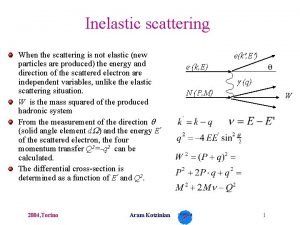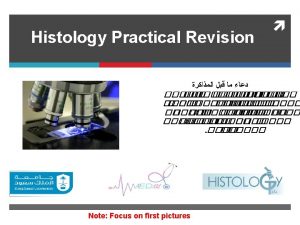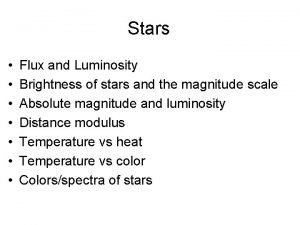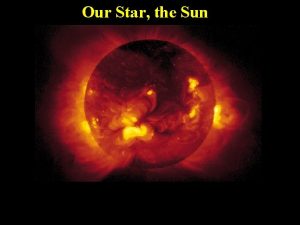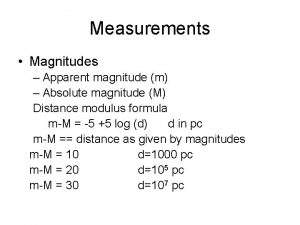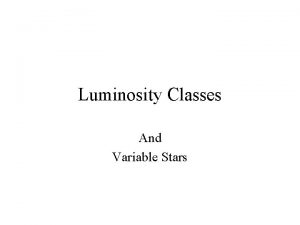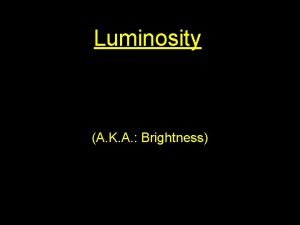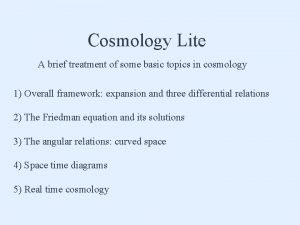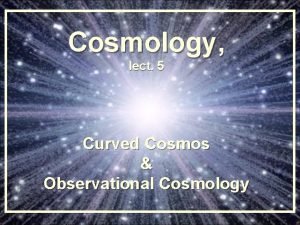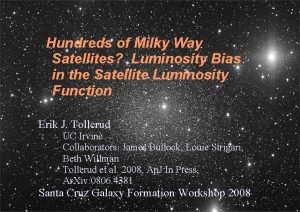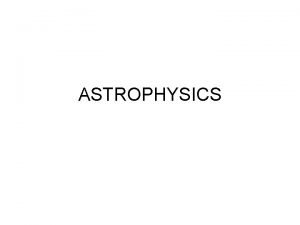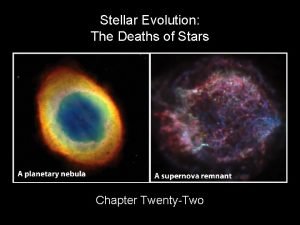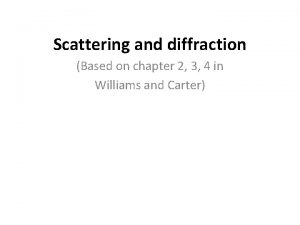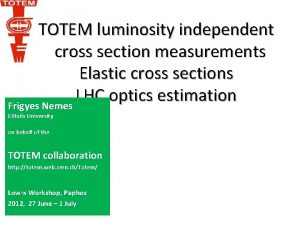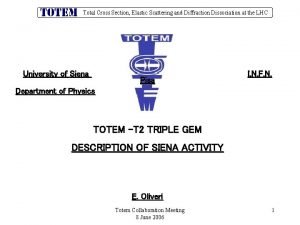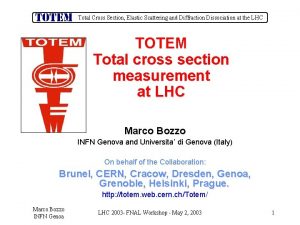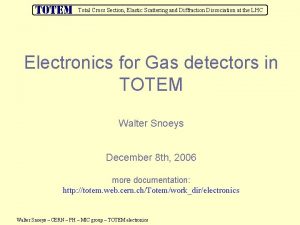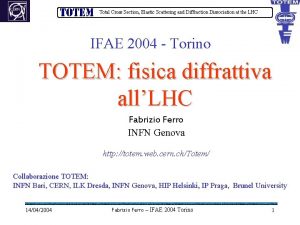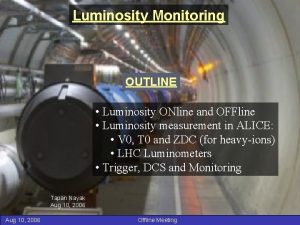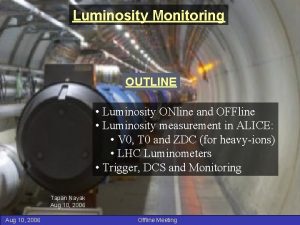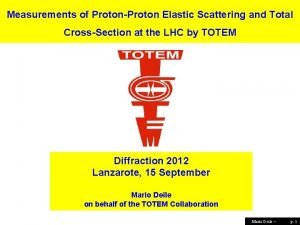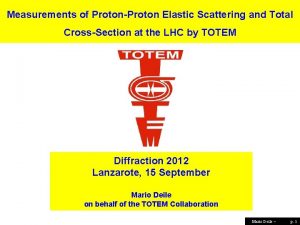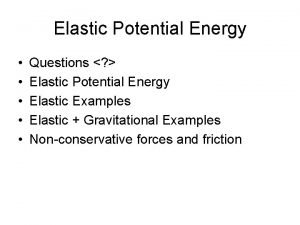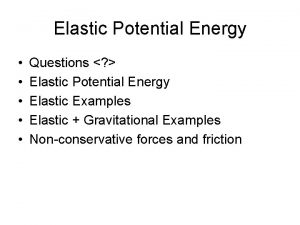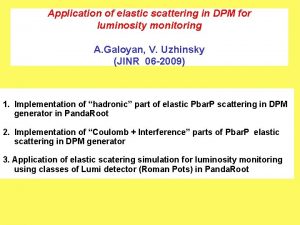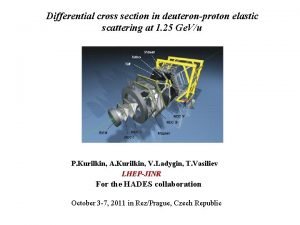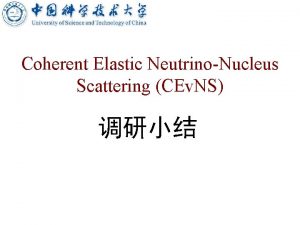Elastic scattering total cross section and luminosity measurements
















- Slides: 16

Elastic scattering, total cross section and luminosity measurements with ATLAS C. Sbarra INFN and University of Bologna On behalf of the ATLAS Luminosity and Forward Physics Working Group § § Introduction Atlas strategy Experimental techniques Current status DESY, Hamburg, 21 -25 May 2007

Elastic Scattering = 14 Te. V prediction of BSW model ds/dt (mb/Ge. V 2) momentum transfer -t ~ (pq)2 q = beam scattering angle p = beam momentum L, stot , b, and r from FIT in CNI region (UA 4) CNI region: |f. C| ~ |f. N| @ LHC: -t ~ 6. 5 10 -4 Ge. V 2; qmin~3. 4 mrad (qmin~120 mrad @ SPS) DESY, Hamburg, 21 -25 May 2007 C. Sbarra

Total Cross-Section Luminosity-independent measurement via optical-theorem simultaneous evaluation of forward elastic and inelastic rate (TOTEM) stot (LHC) ~ 110 mb (g=2; best-fit) stot (LHC) ~ 95 mb (g=1) § elastic rate down to |t|=10 -3 Ge. V 2 to keep extrapolation error small (1 -2%) § Sufficient coverage to access Nel+Ninel Inversely: (stot + d. N/dt|t=0) (DL/L > ~ 2 Dstot/stot) (L (Dstot/stot > ~ ½ DL/L) + d. N/dt|t=0) DESY, Hamburg, 21 -25 May 2007 C. Sbarra

The LHC Luminosity Nxi = number of protons in bunch i of beam x; f=revolution frequency; sx, sy=transverse beam dimensions at the IP; Kb = number of bunches; b*=b function at IP; e. N=s*xs*yg/b* normalized emittance; g=E/mp (~7460) Accuracy limited by § § § Precision in measurement of bunch currents Extrapolation of sxsy from measureament point to IP Beam-beam effects at IP, beam crossing angle, . . . Typical accuracy from machine 5 -10% DESY, Hamburg, 21 -25 May 2007 C. Sbarra

Physics Interest in L Relates the cross section s of a given process to its event rate N=s. L overall normalization of physics analysis; monitor of LHC performances Higgs coupling tanb measurement DL/L=10% DL/L=5% DL/L=10% Systematic error dominated by luminosity (ATLAS TDR ) DESY, Hamburg, 21 -25 May 2007 C. Sbarra

ATLAS Strategy Goal precision on L ~ 2 -3% Elastic scattering in CNI region to get L, b, r and stot at L ~ 1027 cm-2 s-1 (optical theorem as a back-up solution) (ALPHA detector in Roman Pots) Luminosity monitor calibrated at low lumi but working up to L ~ 1034 cm-2 s-1 (LUCID) + § Absolute L from QED (pp ppmm) and QCD (W ln, Z ll) processes (need to control PDF) § Improve Luminosity from machine with ZDC § Further luminosity/beam monitoring with BCM, MBTS. . . DESY, Hamburg, 21 -25 May 2007 C. Sbarra

CNI region challenge Intrinsic Beam divergence during physics run ~ 30 mrad Experimental technique: § Large b* optics beam divergence ~ 0. 2 mrad, low luminosity § independence of vertex position: parallel to point focusing § ALFA detector (scintillating fibers) at 10 -15 sbeam in Roman Pots @ 240 m (after 2009) y* IP parallel-to-point focusing ydet y * b* = 2625 m L ~ 1027 cm-2 s-1 Leff RP Details in dedicated talk RP 240 m RP RP 240 m IP RP DESY, Hamburg, 21 -25 May 2007 RP C. Sbarra

ALPHA performance (H. Stenzel ATL-LUM-PUB-2007 -001) Fit to simulated d. N/dt data corresponding to ~ 1 week (10 M events) of running at L = 1027 cm-2 s-1 Systematics on L § beam divergence and optics § detector acceptance, resolution & alignment § background from halo (beam-gas, off-momentum, betatron oscillations) § Background from non-elastic interactions D L/L ~ 3% - Available after 2009 DESY, Hamburg, 21 -25 May 2007 C. Sbarra

Luminosity Monitor A detector able to count the number m of inelastic interactions per BX by measuring <M> = mean number of charged particles per BX. Calibrated at low luminosity where the average number of particle per detected interaction <N> is measured (small probability of more than 1 interaction per BX) If e is the efficiency to detect one interaction: Calculated e and measured stot only used for consistency cross checks “Luminosity independent” calibration constant A (determined by simultaneous absolute L measurement same precision as L ) Needed dinamic range in m (bunch by bunch L) @ LHC : 2. 5 10 -6 - 25 (S. Ask – ATL-LUM-PUB-2006 -001) DESY, Hamburg, 21 -25 May 2007 C. Sbarra

LUCID LUminosity monitor using Cerenkov Integrating Detector Array of polished aluminum tubes in C 4 F 10 Cherenkov radiator (P=1 bar) light emitted at 3° and read-out after ~ 3 reflections directely (or via optical fiber) by PMT § Cherenkov threshold (10 Me. V for e, 2. 8 Ge. V for p) to limit background § Pointing geometry (limit back. ) § No landau fluctuations (counting particles) § Good time resolution (2 -3 ns) bunch by bunch & on-line luminosity § Light, rad-hard Installation in summer 2007 DESY, Hamburg, 21 -25 May 2007 C. Sbarra

LUCID location Beam pipe Phase I Pseudorapidity coverage 5. 4<| |<6. 1 (5. 6<| |<6. 0) front of tubes at ~ 17 m from IP § 6 -7 MRad/y at L=1034 cm-2 s-1 §. 5 -. 7 MRad/y at low luminosity Radiation test with gammas no problems with PMT up to 20 MRad DESY, Hamburg, 21 -25 May 2007 C. Sbarra

LUCID Phases Phase 1 -low lumi L < ~ 1033 cm-2 s-1 (up to 2009) Approved Feb. 2007 Calibration initially from LHC (10%), then W/Z ln/ll+QED (5 -10%) Phase 2–high lumi L ~ 1034 cm-2 s-1 (after 2009) Calibration with ALPHA precision on L 2 -3% goal Outer layer R=114. 7 mm; Inner layer R=96. 3 mm Tube diameter=15 mm m<~7 16 tubes per side directely read-out by PMT; 4 tubes per side with fibers DESY, Hamburg, 21 -25 May 2007 m~23 168 tubes & winston cones per side read-out via optical fibers to Ma. PMT C. Sbarra

Phase I Measurement Methods: § Collision (zero) Counting - fine in in phase I § Hit Counting - no saturation in phase I § Particle Counting - linear by construction - sensitive to gain fuctuations (Side coincidence / single side) Main method For phase 1 MC expectation Systematics (under study) § Optics differences between calibration and run <~ 1% CLC/CDF experience: DL/L~ 2% + 4% ~ 6% acceptance DESY, Hamburg, 21 -25 May 2007 sinel C. Sbarra

Zero Degree Calorimeter LOI presented in January 2007 (CERN-LHC-2007 -001) Tungsten-quartz fiber calorimeters at ~140 m from the IP housed in the shielding unit that protects the S. C magnets from radiation (TAN) Primary goal: to measure spectator neutrons in heavy ion interactions (centrality) Installation of hadronic module in fall 2007 DESY, Hamburg, 21 -25 May 2007 C. Sbarra

ZDC as a beam monitor ZDC at RHIC as an accelerator tool (in pp) § ZDC (lower curve) bkg free over 4 orders of magnitude § Van der. Meer scan (ZDC coincidence rate vs. relative beam position ) § also measures beam displacement (red points) § Useful for crossing angle commissioning DESY, Hamburg, 21 -25 May 2007 C. Sbarra

Summary & Conclusions Three detectors in forward region § LUCID at 17 m (summer 2007) dedicated luminosity monitor § ZDC at 140 m (fall 2007) LHC parameter calibration/beam monitor § ALFA in Roman Pot at 240 m (after 2009) absolute L, stot, r, b LUCID Calibration § LHC luminosity at the start-up ~10% § Rate of known QED/QCD processes at mid-term ~5% if PDF under control) § ALFA detector after 2009 ~2 -3% Eager to get first beam DESY, Hamburg, 21 -25 May 2007 C. Sbarra
 Scattering cross section in nuclear physics
Scattering cross section in nuclear physics Non elastic scattering
Non elastic scattering Lacunae in bone
Lacunae in bone Luminosity physics
Luminosity physics Stellar flux
Stellar flux Sun surface temperature
Sun surface temperature Absolute magnitude to luminosity
Absolute magnitude to luminosity Luminosity class definition
Luminosity class definition Brightness vs luminosity
Brightness vs luminosity Luminosity distance
Luminosity distance Luminosity distance
Luminosity distance Luminosity
Luminosity Spectral class
Spectral class Luminosity
Luminosity Luminosity lpi
Luminosity lpi Area of cross section formula
Area of cross section formula Diffraction and scattering
Diffraction and scattering

